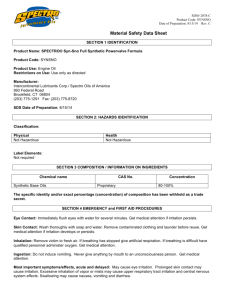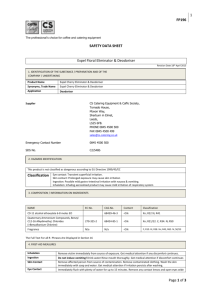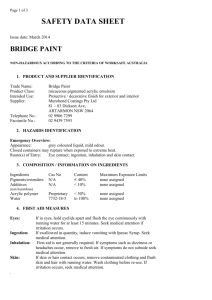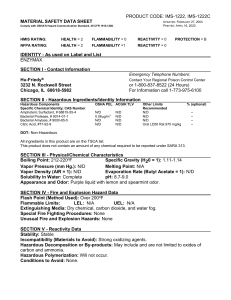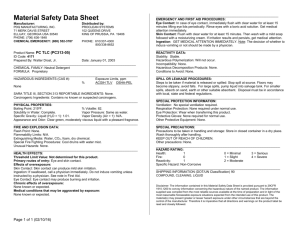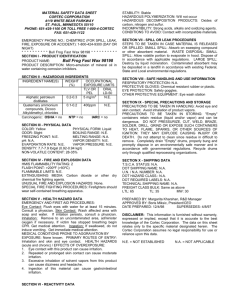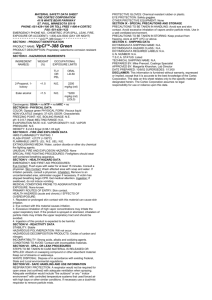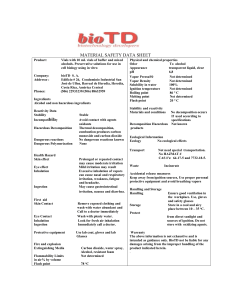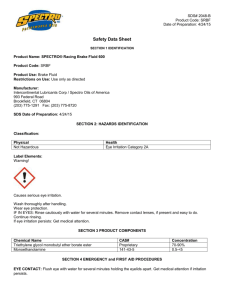BSA - Spectro Oils
advertisement
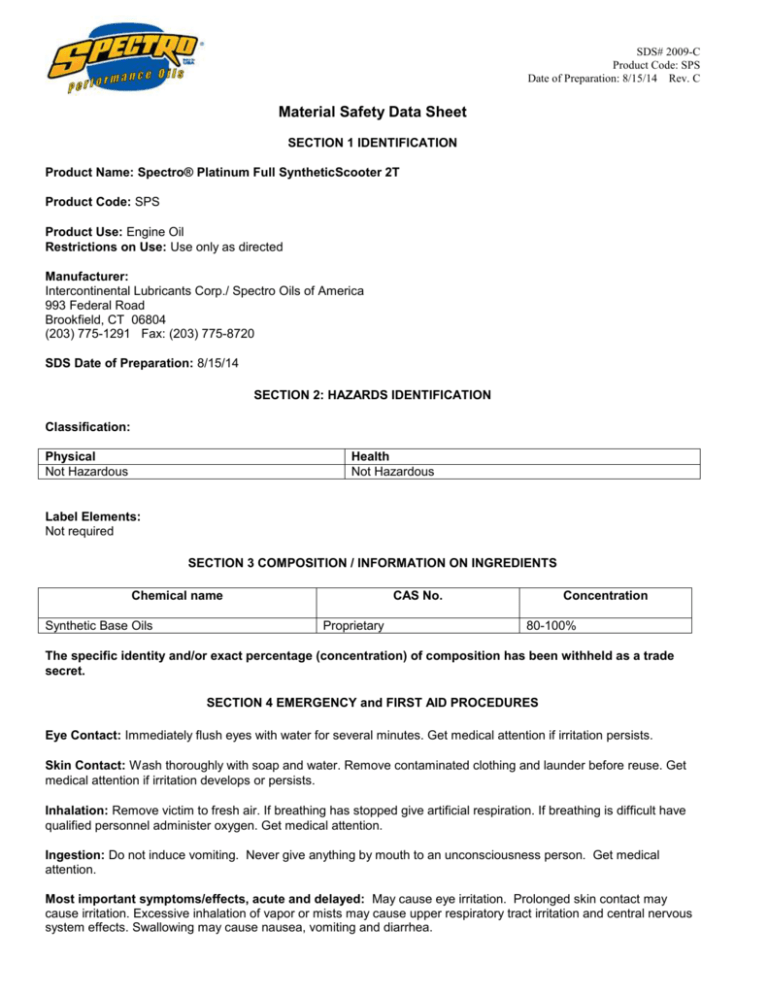
SDS# 2009-C Product Code: SPS Date of Preparation: 8/15/14 Rev. C Material Safety Data Sheet SECTION 1 IDENTIFICATION Product Name: Spectro® Platinum Full SyntheticScooter 2T Product Code: SPS Product Use: Engine Oil Restrictions on Use: Use only as directed Manufacturer: Intercontinental Lubricants Corp./ Spectro Oils of America 993 Federal Road Brookfield, CT 06804 (203) 775-1291 Fax: (203) 775-8720 SDS Date of Preparation: 8/15/14 SECTION 2: HAZARDS IDENTIFICATION Classification: Physical Not Hazardous Health Not Hazardous Label Elements: Not required SECTION 3 COMPOSITION / INFORMATION ON INGREDIENTS Chemical name Synthetic Base Oils CAS No. Proprietary Concentration 80-100% The specific identity and/or exact percentage (concentration) of composition has been withheld as a trade secret. SECTION 4 EMERGENCY and FIRST AID PROCEDURES Eye Contact: Immediately flush eyes with water for several minutes. Get medical attention if irritation persists. Skin Contact: Wash thoroughly with soap and water. Remove contaminated clothing and launder before reuse. Get medical attention if irritation develops or persists. Inhalation: Remove victim to fresh air. If breathing has stopped give artificial respiration. If breathing is difficult have qualified personnel administer oxygen. Get medical attention. Ingestion: Do not induce vomiting. Never give anything by mouth to an unconsciousness person. Get medical attention. Most important symptoms/effects, acute and delayed: May cause eye irritation. Prolonged skin contact may cause irritation. Excessive inhalation of vapor or mists may cause upper respiratory tract irritation and central nervous system effects. Swallowing may cause nausea, vomiting and diarrhea. SDS# 2009-C Product Code: SPS Date of Preparation: 8/15/14 Rev. C Indication of immediate medical attention and special treatment, if necessary: None required under normal conditions of use. SECTION 5 FIRE and EXPLOSION HAZARD DATA Suitable extinguishing media: Water fog, foam, carbon dioxide, dry chemical. Specific hazards arising from the chemical: Not classified as a combustible liquid but will burn under fire conditions. At elevated temperatures containers may rupture. Use of large amounts of water may cause product to float and spread fire. Special protective equipment and precautions for fire-fighters: Firefighters should wear full emergency equipment and a NIOSH approved positive pressure self-contained breathing apparatus. Cool exposed intact containers with water spray or stream. SECTION 6 ACCIDENTAL RELEASE MEASURES Personal precautions, protective equipment, and emergency procedures: Wear appropriate protective equipment. Wash thoroughly after handling. Environmental hazards: Avoid release into the environment. Report spill as required by local and federal regulations. Methods and materials for containment and cleaning up: Dike spill and collect into closable containers for disposal with an inert absorbent. Prevent entry in storm sewers and waterways. SECTION 7 HANDLING and STORAGE Precautions for safe handling: Avoid contact with eyes and prolonged or repeated contact with skin and clothing. Avoid breathing vapors and mists. Wash thoroughly after handling. Remove oil-soaked clothing and launder before re-use. Conditions for safe storage, including any incompatibilities: Store in a cool area away from oxidizing agents. Protect containers from physical damage. Empty containers retain product residues. Do not cut, weld, braze, etc. on or near empty containers. Follow all SDS precautions in handling empty containers. SECTION 8 EXPOSURE CONTROLS and PERSONAL PROTECTION Exposure Guidelines: INGREDIENTS Synthetic Oils* EXPOSURE LIMITS 5 mg/m3 TWA Manufacturer . Appropriate engineering controls: Good general room ventilation (equivalent to outdoors) should be adequate under normal conditions. . If the recommended exposure limit is exceeded increased mechanical ventilation such as local exhaust may be required. Respiratory protection: None needed under normal use conditions with adequate ventilation. If exposures are excessive, use a NIOSH approved respirator with organic vapor cartridges and particulate pre-filter. Selection of respiratory protection depends on the contaminant type, form and concentration. Select in accordance with OSHA 1910.134 and good Industrial Hygiene practice. Skin protection: Rubber, neoprene or other impervious gloves are recommended where prolonged or repeated skin contact is likely. Eye protection: Safety glasses or goggles if splashing is possible. Page 2 of 5 SDS# 2009-C Product Code: SPS Date of Preparation: 8/15/14 Rev. C Other: Impervious apron, boots and other clothing are recommended if needed to avoid prolonged/repeated skin contact. Suitable washing facilities should be available. SECTION 9 PHYSICAL and CHEMICAL PROPERTIES Appearance (physical state, color, etc.): Clear liquid Odor: Hydrocarbon odor. Odor threshold: Not available Melting point/Pourpoint: -42°C / --44°F Flash point: 201°F / 94°C Flammability (solid, gas): Not applicable Flammable limits: LEL: Not applicable Vapor pressure: <0.1 mmHg Relative density: 0.848 Partition coefficient: n-ctanol/water: Not available Decomposition temperature: Not available pH: Not available Boiling Point: Not available Evaporation rate: Not available UEL: Not applicable Vapor density: Not available Solubility(ies): Negligible in water Auto-ignition temperature: Not available Viscosity: 37 cSt @ 40°C SECTION 10 STABILITY and REACTIVITY Reactivity: This product is not expected to react. Chemical stability: The product is stable. Possibility of hazardous reactions: May react with oxidizing to generate heat. Conditions to avoid: Avoid excessive heat. Incompatible materials: Avoid strong oxidizing agents. Hazardous decomposition products: Thermal decomposition may yield carbon monoxide, carbon dioxide and hydrocarbon fragments. SECTION 11 TOXICOLOGICAL INFORMATION Health Hazards: Inhalation: Excessive inhalation of vapors or mists may cause upper respiratory tract irritation. Skin Contact: Prolonged or repeated contact may cause mild irritation or dryness. Eye Contact: May cause mild irritation. Ingestion: Swallowing large amounts may cause gastrointestinal effects including nausea and diarrhea. . Chronic Effects of Overexposure: No adverse chronic effects are expected. Mutagenicity: This product is not expected to cause mutagenic activity. Reproductive Toxicity: This product is not expected to cause reproductive or developmental effects. Carcinogenicity: None of the components of this product are listed as a carcinogen or suspected carcinogen by IARC, NTP, ACGIH or OSHA. Acute Toxicity Values: Product: Oral rat LD50 >5000 mg/kg; Dermal rabbit LD50 >5000 mg/kg: Page 3 of 5 SDS# 2009-C Product Code: SPS Date of Preparation: 8/15/14 Rev. C SECTION 12: ECOLOGICAL INFORMATION Ecotoxicity: Product: No data available Persistence and degradability: No data available Bioaccumulative potential: No data available. Mobility in soil: The product may float and can migrate from water to land. Other adverse effects: None known. SECTION 13: DISPOSAL INFORMATION Waste Disposal Method: Dispose in accordance with all local, state and federal regulations. SECTION 14: TRANSPORTATION INFORMATION UN Number DOT TDG IMDG IATA Proper shipping name Hazard Class Packing Group Environmental Hazard Not Regulated Not Regulated Not Regulated Not Regulated Transport in bulk (according to Annex II of MARPOL 73/78 and the IBC Code): Not applicable – product is transported only in packaged form. Special precautions: None known. SECTION 15: REGULATORY INFORMATION Safety, health, and environmental regulations specific for the product in question. CERCLA: This product is not subject to CERCLA reporting requirements, however, oil spills are reportable to the National Response Center under the Clean Water Act and many states have more stringent release reporting requirements. Report spills required under federal, state and local regulations. EPA SARA 311 Hazard Classification: Not Hazardous. SARA 313: This product contains the following chemicals subject to Annual Release Reporting Requirements Under SARA Title III, Section 313 (40 CFR 372): None WHMIS CLASSIFICATION: Not a controlled product. This product has been classified in accordance with the hazard criteria in the CPR and the MSDS contains all the information required by the CPR. CALIFORNIA PROPOSITION 65: This product contains the following chemicals which are known to the State of California to cause cancer or reproductive toxicity: None International Chemical Inventories Australia AICS: All of the components are listed on the Australian Inventory of Chemical Substances. Page 4 of 5 SDS# 2009-C Product Code: SPS Date of Preparation: 8/15/14 Rev. C Canada DSL: All of the components are listed on the Canadian Domestic Substances List. China: All the components are listed on Inventory of Existing Chemical Substances in China. European EINECS: All of the ingredients are listed on the EINECS inventory. Japan: All the components are listed in the Japanese Existing and New Chemical Substances Inventory. Korea: All the components are listed on the Korean Existing Chemical List. New Zealand: All the components are listed on the New Zealand Inventory of Chemicals. Philippines: All the components are listed on the Philippine Inventory of Chemical and Chemical Substances inventory. US EPA Toxic Substances Control Act: All of the components of this product are listed on the TSCA inventory. SECTION 16: OTHER INFORMATION Revision Summary: 8/15/14: Convert to GHS format. All section revised. Page 5 of 5
